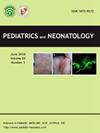Clinical Features of iatrogenic Pharyngo-esophageal perforation in very low birth weight infants
IF 2.3
4区 医学
Q2 PEDIATRICS
引用次数: 0
Abstract
Background
Iatrogenic pharyngoesophageal perforation (IPEP) is one of the complications of gastric tube insertion and it tends to occur more frequently in premature infants. Although the frequency is significantly low, attention should be paid as it can lead to serious outcomes with high mortality. This study will help raise awareness with respect to early diagnosis, management, and prevention.
Methods
We performed a retrospective cohort study of all very low birth weight infants diagnosed with IPEP between 1993 and 2022.
Results
A total of 6 patients (0.27% of very low birth weight infants) with the diagnosis of IPEP were included. The median gestational age was 27 + 1 weeks (range 23+5–28 + 6 weeks), and the median birth weight was 823 g (range 630–1232 g). Symptoms included difficulty with gastric tube insertion, bloody secretions in the oral cavity, and increased oral secretions. X-rays revealed aberrant running of the gastric tube in all patients. In three cases, contrast studies demonstrated contrasted mediastinum tapering like a bead. Laryngoscope was used to view the perforation sites but this was not useful in the smallest patient. All patients were treated conservatively with antibiotics and survived.
Conclusions
When inserting a gastric tube for premature infants, it is critical to remember that these infants are at risk of IPEP. In addition to a frontal X-ray, a lateral X-ray and contrast study may be useful for early diagnosis.
极低出生体重儿先天性咽喉食道穿孔的临床特征
本文章由计算机程序翻译,如有差异,请以英文原文为准。
求助全文
约1分钟内获得全文
求助全文
来源期刊

Pediatrics and Neonatology
PEDIATRICS-
CiteScore
3.10
自引率
0.00%
发文量
170
审稿时长
48 days
期刊介绍:
Pediatrics and Neonatology is the official peer-reviewed publication of the Taiwan Pediatric Association and The Society of Neonatology ROC, and is indexed in EMBASE and SCOPUS. Articles on clinical and laboratory research in pediatrics and related fields are eligible for consideration.
 求助内容:
求助内容: 应助结果提醒方式:
应助结果提醒方式:


